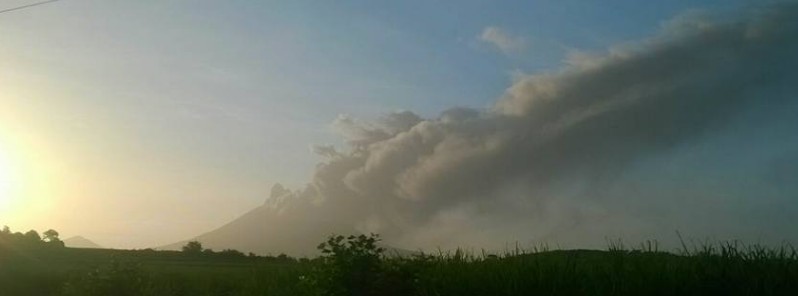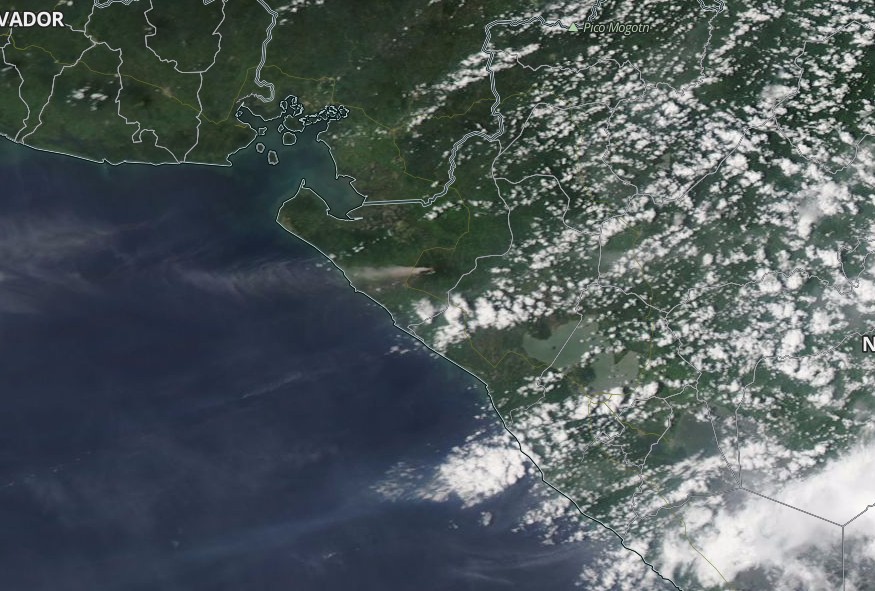Ash emission from San Cristobal volcano affects 50 000 people, Nicaragua

Nicaraguan authorities reported a new ash emission started at San Cristobal volcano early Friday morning, August 18, 2017. The last eruption of this volcano took place on April 22, 2016.
The volcano began degassing Friday morning, followed by an expulsion of ash and strong sulfuric stench from 05:18 CST (11:18 UTC). Ashfall affected 86 localities in Chinandega and 92 in El Viejo, which is more than 50 000 citizens, La Prensa reported.

Credit: NASA Aqua/MODIS. Acquired: August 18, 2017
The Municipal Committee for Disaster Prevention (COMUPRED) held an emergency meeting and warned citizens of possible health problems caused by ashfall, which remained constant for almost 5 hours.
Residents near the volcano, and those affected by ashfall, are reminded to use masks or wet towels to cover their mouth, nose and eyes.
El #SanCristobal manifestándose. A protegerse y tapar alimentos por la caída de ceniza. pic.twitter.com/awDHjKVjyE
— ivett blandon (@ibt_blandon) August 18, 2017
#Urgente: Registran erupción en el volcán San Cristóbal. Las clases se han suspendido en las comunidades afectadas https://t.co/GSsLj5dC9v pic.twitter.com/wAnNoFUoQ9
— 100%NOTICIAS (@100noticiasni) August 18, 2017
@jeanjairios Proceso de desgasificacion del volcán San Cristóbal expulsando cenizas por toda la ciudad de chinandega,Nicaragua.#SanCristobal pic.twitter.com/ieElr7sH7z
— Juan F Munguia (@jeanjairios) August 18, 2017
#nicaragua #sancristobal #volcansancristobal #volcano #pinolero #nicapeople #nicaraguan #nicaraguense #tgif pic.twitter.com/IDpG1HPpYT
— FDV_FPV (@Fredy_Dv) August 18, 2017
So far, there were no registered explosions, SINAPRED said earlier today.
At 15:02 UTC, the Washington VAAC reported latest imagery now shows new emission of gasses and possible volcanic ash moving towards the west at 46 to 55 km/h (29 – 34 mph). INETER estimated height at 2.1 km (7000 feet) above sea level.
The last eruption of this volcano took place at 10:20 CST on April 22, 2016. INETER and SINAPRED reported an ash-and-gas plume rose 2 km (6 561 feet) above crater, drifting SW. The seismic network detected 10 additional explosions by 12:00 CST. The previous explosive activity at the volcano occurred on June 6, 2015.
Geological summary
The San Cristóbal volcanic complex, consisting of five principal volcanic edifices, forms the NW end of the Marrabios Range. The symmetrical 1745-m-high (5 725 feet) youngest cone, named San Cristóbal (also known as El Viejo), is Nicaragua's highest volcano and is capped by a 500 x 600 m (1 640 x 1 968 feet) wide crater.
El Chonco, with several flank lava domes, is located 4 km (2.5 miles) W of San Cristóbal; it and the eroded Moyotepe volcano, 4 km NE of San Cristóbal, are of Pleistocene age. Volcán Casita, containing an elongated summit crater, lies immediately east of San Cristóbal and was the site of a catastrophic landslide and lahar in 1998.
The Plio-Pleistocene La Pelona caldera is located at the eastern end of the complex. Historical eruptions from San Cristóbal, consisting of small-to-moderate explosive activity, have been reported since the 16th century. Some other 16th-century eruptions attributed to Casita volcano are uncertain and may pertain to other Marrabios Range volcanoes. (GVP)
Featured image: Gas and ash emission at Kanlaon volcano on August 18, 2017. Credit: SINAPRED

Commenting rules and guidelines
We value the thoughts and opinions of our readers and welcome healthy discussions on our website. In order to maintain a respectful and positive community, we ask that all commenters follow these rules.